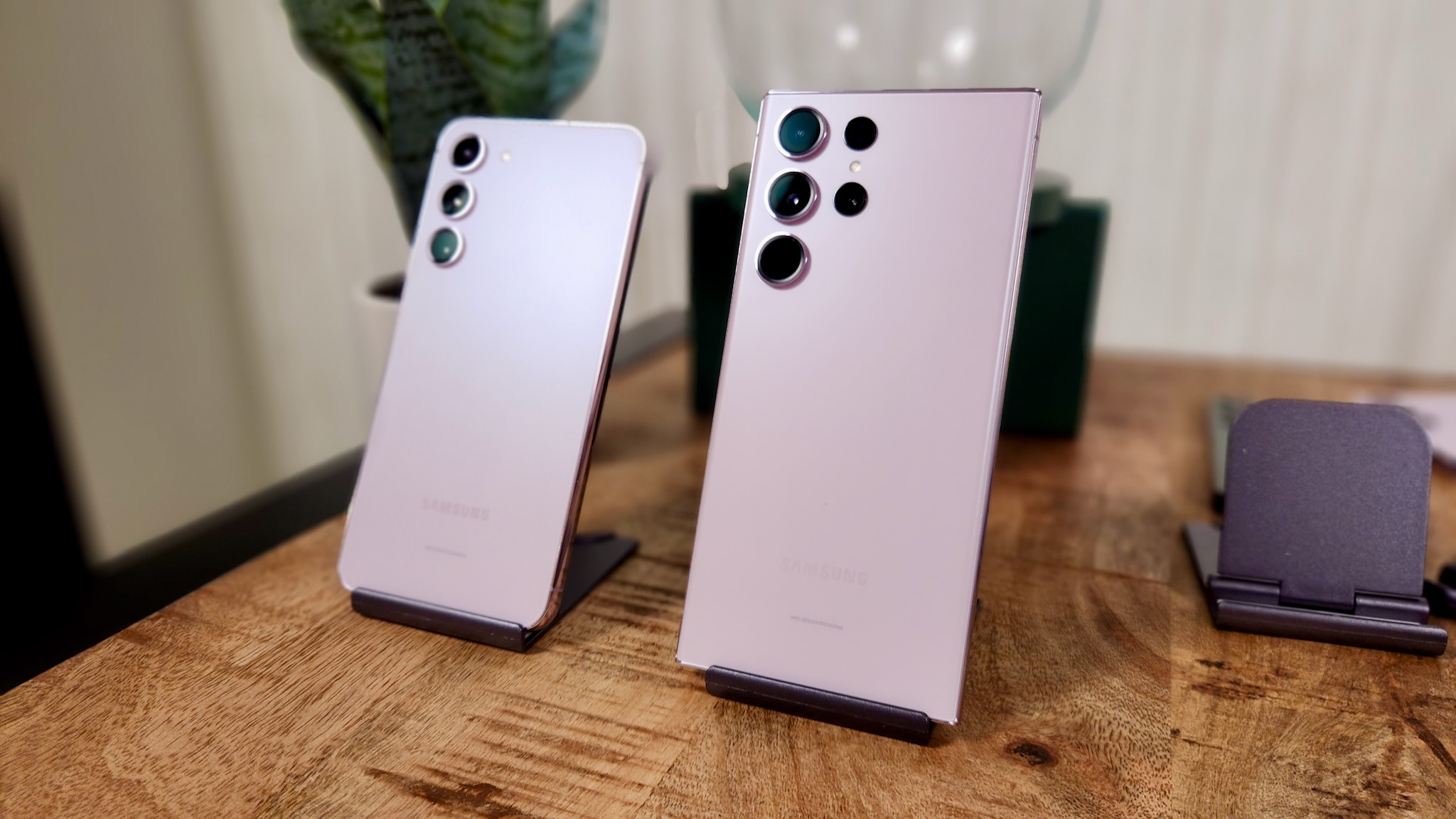Samsung's Galaxy S23+ strategy is the iPhone 14 Plus all over again
A few consumers want cheap-but-big phones, but $1,000 is too much to spend on an 8GB phone in 2023.

Ever since the Galaxy S20+ topped Samsung's 2020 flagships sales, the Plus model has dipped dramatically in popularity, with the Galaxy S22+ falling well short of the Ultra and base models. Although the Samsung Galaxy S23+ makes a couple of key upgrades over the S22+, its chance of success will likely be scuttled by Samsung's insistence on reserving the best features for the Galaxy S23 Ultra.
When I reviewed the Galaxy S22 Plus last year, I appreciated how it struck the right balance between the too-small Galaxy S22 with its poor battery and the massive S22 Ultra with its uncomfortable form factor. Beyond a Snapdragon 8 Gen 1 chip with overheating issues — something arguably outside of Samsung's control — the most important downside was that the S22+ only had 8GB of RAM and an FHD display.
With the Galaxy S23+, not much has changed aside from the new Snapdragon chip and a battery that's 200mAh larger. It uses a 50MP camera again, but Samsung assured us that it's a significant improvement with "four times wider dynamic range" and improved AI remastering. Yes, the Galaxy S23 Ultra has its 200MP sensor and 100X space zoom, but the S23+ 50MP camera still has the chops to compete strongly against other brands thanks to robust AI optimization.
We were less convinced by Samsung's explanation for sticking to 8GB. Its reps touted the default 256GB storage and claimed that most customers who want the Plus model are just looking for a bigger screen and longer-lasting battery. Only power users who would buy the Ultra would even need or seek out 12GB, they argue. And no doubt they'd argue the same for why the Galaxy Plus series doesn't need QHD resolution.
Even if we buy this argument — rather than the more likely explanation that the shortcomings of the S23+ encourage people to spend more on the S23 Ultra, or that it's a cost-cutting measure — the problem is that the Android flagship market (and iPhones) are moving forward in this area while Samsung treads water, relying on its Snapdragon chips and lack of competition in key markets to compensate.
12GB isn't an unreasonable request

If you consider the Pixel 7 Pro ($899), IQOO 11 (~$800), Xiaomi 12S (~$960), and OnePlus 10 Pro (~$1,100), all of them launched with 12GB memory and QHD+ resolution, while many of them also came in 8GB variants for hundreds less. Beyond this sweet spot, you'll find plenty of Chinese phones that stick to FHD resolution but offer an upgrade to 12GB or even 16GB, while still falling into the sub-$1,000 threshold.
Samsung obviously has fewer Android competitors in North America, but with the iPhone 14 Pro ($1,000), its 460ppi resolution isn't quite QHD but handily beats FHD, and its CPU performance crushes that of any Android phone despite 6GB of RAM. Most importantly, Apple didn't reserve any features for the Pro Max, so no one sees the Pro as a compromise.
Get the latest news from Android Central, your trusted companion in the world of Android
Sure, the Galaxy S23+ has an ultra-bright 120Hz display, but that refresh rate threshold is becoming increasingly common even with mid-range Android phones like its own Galaxy A53 5G, and the Galaxy S23 matches it for display brightness, refresh rate, and protection.
After Samsung's infamous throttling issues with the Galaxy S22, it would've been a relief if the brand had made 12GB an option without having to spend $1,200. The Ultra could still have exclusives like QHD, its epically powerful cameras, and the S Pen to draw in enthusiasts. Instead, the Galaxy S23+ is truly just a "Plus" phone with plus-sized storage and a big display for $200 more.
Will the Snapdragon 8 Gen 2 save the Galaxy S23+?

Our colleagues at iMore explained just how badly Apple's iPhone 14 Plus experiment failed last year. No doubt Apple thought plenty of people would pay just $100 more for a larger screen, but no one wanted a $900 phone with mid-tier specs.
The Galaxy S23+ isn't a mid-tier phone, to be clear. The flagship Snapdragon 8 Gen 2 should give it a solid performance upgrade, as my colleague Harish Jonnalagadda found in his 8 Gen 2 performance tests.
But Harish also made clear that daily use speeds won't be much different from 2022 phones; the difference will be that the 8 Gen 2 is "absolutely amazing for gaming, and it manages to deliver sustained performance without any throttling whatsoever" on his 12GB iQOO 11. The question will be whether or not this same multi-core upgrade for gaming comes across as well for the Galaxy S23 and S23+ with more limited RAM.
If the Galaxy S23+ performs well, that could be the differentiator that it needs, as a great gaming phone that's a little more affordable than the Galaxy S23 Ultra. But after Samsung's alleged benchmark cheating last year, we'll have to get our hands on it and test it for ourselves to see how it holds up.
Samsung's phone business is at a Plus-sized crossroads

Last month, The Elec released a disputed report that Samsung plans to abandon the Plus lineup starting with the Galaxy S24 series, based on only seeing the terms "DM1" and "DM3" in a report and assuming this referred to the S24 and S24 Ultra, with the S24+ absent. However, WinFuture's Roland Quandt tweeted that DM is short for diamond, the internal codename for the S23 series — undermining The Elec's claim.
Still, a lot of sites took The Elec at face value because the claim seemed so plausible. Most brands these days only release a standard and pro model, and the last two Plus phones haven't sold especially well. Samsung has also seemingly abandoned the Galaxy FE lineup after the S21 FE flopped, and with Samsung's profits at an 8-year low, it may decide to shake things up.
I don't want Samsung to abandon the Plus. I'm a strong proponent of one-handed phones, which means that as much as I like One UI software, I don't think I could ever buy a Galaxy S23 Ultra (or any other Ultra).
Samsung seems to have no plans to abandon it. In a panel with Wonjoon Choi, Samsung EVP and head of R&D Mobile, he was asked about the S23+ and said that they don't just sell three phones for three's sake. They believe there's a "sufficient user base" who have a "different set of needs" fulfilled by the S23+. Plus, he suggested that the performance boost provided by the Snapdragon 8 Gen 2 isn't just something you'll get on the S23 Ultra.
In my short time with it, the Galaxy S23+ seemed comfortable to hold and has a pretty display that I'd really enjoy playing Android games or cloud games on. I just wish it had the memory chops necessary to make the Galaxy S23+ a best-selling device again with the enthusiasts who care about specs more than Samsung cares to admit. But I'll be reviewing the S23+ soon myself, and I will test to see whether its performance boost over the S22+ is enough to make consumers happy.
I'd argue Samsung's software and camera quality makes it more tempting than other brands that compensate with better hardware. Still, even if we include the S23+ on our list of the best Android phones after we complete our review, it's likely the more affordable Galaxy S23 and premium Galaxy S23 Ultra will supplant it, both in our rankings and in consumers' interest.

Michael is Android Central's resident expert on wearables and fitness. Before joining Android Central, he freelanced for years at Techradar, Wareable, Windows Central, and Digital Trends. Channeling his love of running, he established himself as an expert on fitness watches, testing and reviewing models from Garmin, Fitbit, Samsung, Apple, COROS, Polar, Amazfit, Suunto, and more.
